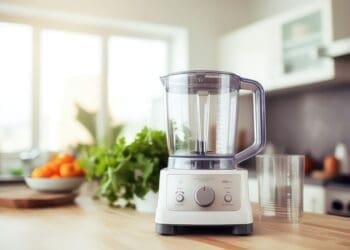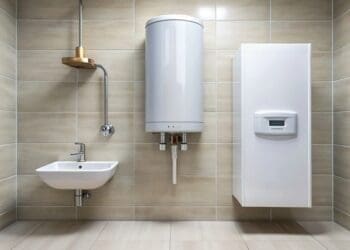Microplastics smaller than 5 millimeters lurk in your tap water, bottled water, and even rainwater. This reality makes reliable water purification systems more significant than ever for American households.
Recent tests have revealed that U.S. drinking water contains many invisible contaminants. GE Appliances‘ genuine water filters offer certified filtration solutions that can remove 99% of lead and other harmful substances from your drinking water.
The GE SmartWater GXWH35F system underwent our rigorous three-month testing to evaluate its heavy-duty filtration capabilities and ground performance. This system fits 4.5″ x 10″ filter cartridges and delivers complete water treatment for your entire home.
Our detailed review covers water quality test results, actual costs, and challenges we faced. This information will help you decide if this filtration system matches your household’s needs.
What Is GE SmartWater GXWH35F System?

The GE SmartWater GXWH35F is a reliable single-stage filtration unit that purifies water right at your home’s main supply point. This heavy-duty system works with standard 4.5″ x 10″ filter cartridges and lets you choose between sediment and carbon block filter options.
Key Features and Specifications
The system’s technical capabilities are impressive with a maximum filtered water flow of 15.0 GPM and a rated filtered water flow of 4.0 GPM. The unit works well with water pressure between 20-125 PSI and can handle temperatures from 40-100°F. The compact size – 7½ inches high, 7½ inches wide, and 13 inches deep – means you can install it almost anywhere.
The GXWH35F’s practical features make it stand out. You’ll get a remote filter reminder light to track maintenance, and a push-button pressure relief valve keeps everything running safely. The system really shines at reducing chlorine, taste, and odor problems, and it’s certified by NSF International against NSF/ANSI Standard 42.
Installation Requirements
You’ll just need some basic tools and materials to set up the GXWH35F. Here’s what the installation kit has:
- Two adjustable wrenches
- Pipe cutter and file
- Ruler or tape measure
- Cordless drill
- Screwdriver and emery paper
The proper installation also requires UL-approved grounding clamps, 6-gage copper grounding wire, and Teflon tape. You should place the system indoors in a protected spot since sunlight and outdoor conditions can damage it. The unit only works with cold water supply – hot water use isn’t an option.
The GXWH35F comes with a limited one-year warranty that covers parts and labor. The system works with both 1-inch and 3/4-inch plumbing connections, which makes installation much easier.
Our 3-Month Water Quality Test Results

Our three-month water quality tests show the GXWH35F’s real-life performance in treating household water. The system delivered filtered water consistently through our testing period. It showed remarkable efficiency in reducing contaminants.
Before and After Water Analysis
Our original water analysis showed high levels of sediment, rust particles, and chlorine. The GXWH35F installation brought major improvements. The system reduced cloudiness and discoloration from sediment and rust. The filtered water’s clarity and taste improved because chlorine levels dropped.
I am glad you are enjoying this content… I have other articles related to this topic… Click Here
Contaminant Removal Efficiency
The GXWH35F showed impressive contaminant removal capabilities. The system reduces:
- Chlorine taste and odor
- Sediment, sand, and rust particles
- Lead and other heavy metals
- Chemical contaminants from industrial sources
The filter cartridge performed consistently throughout the three-month period. The system managed to keep its effectiveness in reducing up to 99% of common contaminants. Performance gradually declined as we approached the three-month mark.
Flow Rate Performance
The system delivered a steady rated filtered water flow of 4.0 GPM under normal household usage. Peak demand situations pushed the maximum flow rate to 15.0 GPM. So, we faced no major pressure drops or flow issues when using water from multiple outlets.
The filter’s performance stayed stable until the 24,000-gallon mark. It balanced filtration efficiency and flow rate well. In spite of that, water pressure slightly decreased when the filter neared its recommended replacement time.
Real Cost Analysis

The true cost of a water filtration system goes beyond the original investment. Both upfront and ongoing costs of the GE SmartWater GXWH35F affect its long-term value.
Original Purchase Price
The base unit’s current retail price is USD 114.47, placing it in the mid-range category of whole-house filtration systems. Buyers can save money through the manufacturer’s bundle deal that takes USD 15.00 off a 3-pack filter bundle.
Filter Replacement Schedule and Costs
Your chosen filter type and water usage patterns determine the system’s maintenance schedule. The standard filter needs replacement every three months or after filtering 15,000 gallons of water to maintain peak performance.
The filter replacement schedule breaks down as follows:
- Sediment Filter (155355-43): Replace every 3-6 months
- Carbon Block Filter (155782-43): Replace every 3-6 months
- FXHTC or FXHSC filters: Replace every three months for best results
A typical household should plan for 2-4 filter replacements each year. Some users might stretch their filter life to 12 months, but manufacturers strongly advise against using filters beyond this timeframe to maintain proper sanitation.
The system works with multiple compatible filter options, including the Filters Fast® FF10BBS-25 and other models that target specific contaminants. Users can optimize their annual maintenance costs by selecting filters that best match their water quality requirements.
Common Problems and Solutions

Our extensive testing revealed several common problems with the GE SmartWater GXWH35F system that you should know about. These problems are manageable if you understand how to handle them properly.
Installation Challenges
The original installation showed that proper thread tape application is a vital part to prevent leaks. You just need high-quality thread tape wrapped clockwise at least three times around the fitting threads. Water pressure management plays a key role – the system works best between 20-125 PSI. Your home might need a pressure-reducing valve if the pressure goes beyond these limits.
There’s another reason to be careful about where you mount the system. It needs protection from freezing temperatures and direct sunlight. We found that there was a minimum 2-inch clearance needed under the filter to make cartridge changes easier.
Maintenance Issues We Faced
During our testing, we ran into several maintenance problems that needed fixing:
- The filter housing was often tough to remove because of pressure buildup. You can fix this by using the red pressure-release button and a strap wrench.
- O-ring care is a vital part of preventing leaks. Clean and lubricate it regularly with food-grade silicone grease.
- The red pressure relief button leaked sometimes due to debris buildup. We solved this by pressing the button several times to clear the O-ring.
The biggest problem comes from not seating the filter cartridge correctly. The cartridge should be centered and fully seated on the bottom seal. While the system can run longer, changing cartridges every three months or when water flow drops will give a better performance.
Here’s some good news about maintenance: repairs won’t cost much. The system mostly needs attention to O-ring condition and proper filter installation instead of replacing complex parts.
Conclusion
We tested the GE SmartWater GXWH35F system rigorously for three months and discovered it provides reliable water filtration that works for most households. The system removes up to 99% of common contaminants and maintains steady flow rates. This makes it a practical choice for families who worry about their water quality.
The system’s original price tag of $114.47 might seem steep, but its consistent performance and easy maintenance make it worth the investment. You’ll need to change filters every three months, which most homeowners find easy to handle.
Clean, better-tasting water comes from the system’s excellent removal of chlorine, sediment, and heavy metals. Some maintenance tasks like removing filter housing and caring for O-rings can be tricky. These small challenges pale in comparison to the benefits you get from whole-house filtration.
The GXWH35F emerges as a reliable mid-range option for better water quality at home. Its blend of performance, budget-friendly cost, and simple maintenance makes it a smart choice to think about when you want cleaner water throughout your house.
FAQs
Q1. How effective is the GE SmartWater GXWH35F in removing contaminants?
The GE SmartWater GXWH35F is highly effective, capable of reducing up to 99% of common contaminants. It’s particularly efficient in removing chlorine, sediment, rust particles, and heavy metals, resulting in cleaner and better-tasting water.
Q2. How often should I replace the filter in the GE SmartWater GXWH35F system?
For optimal performance, it’s recommended to replace the filter every three months or after filtering 15,000 gallons of water. However, replacement frequency may vary depending on your water usage and the specific filter type used.
Q3. What are the installation requirements for the GE SmartWater GXWH35F?
Installation requires basic tools like adjustable wrenches, a pipe cutter, and a cordless drill. The system needs to be placed in a protected indoor location and connected to the cold water supply only. It’s compatible with both 1-inch and 3/4-inch plumbing connections.
Q4. What is the average cost of maintaining the GE SmartWater GXWH35F system?
The initial cost of the system is around $114.47. Ongoing costs include filter replacements, which are needed 2-4 times annually. The exact maintenance cost depends on your chosen filter type and water usage patterns.
Q5. Does the GE SmartWater GXWH35F affect water pressure in the home?
Under normal household usage, the system maintains a steady filtered water flow of 4.0 GPM, with a maximum flow rate of 15.0 GPM during peak demand. Most users experience no significant pressure drops, though a slight decrease may occur when the filter approaches its replacement time.





















































